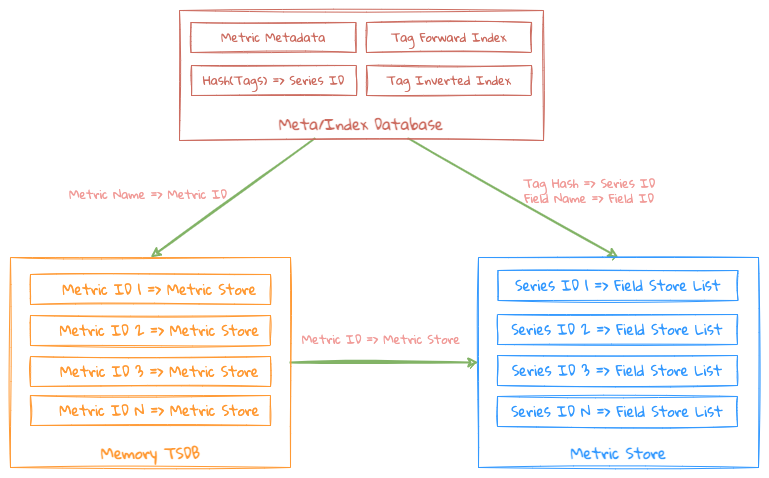Memory database
Memory structure

The entire memory structure is more like a memory sequential storage, which mainly consists of the following 2 blocks:
Metric Meta/Index: It mainly stores the indexes ofMetric MetadataandTags;Metric Metadata: Store whichFieldand whichTag Keyscorrespond to theMetric, and generate a database-level globally uniqueIDfor eachTag Key, which is convenient forTag IndexStorage in the underlyingKV Store;Metric Index: Mainly to make an inverted index for theTag Valuesunder eachMetric Tag Key,Termis the correspondingTag Value,Posting Listis the correspondingMetricSeries ID;Hash(Tags)=>Series ID: Calculate whether the correspondingSeries IDalready exists throughTags Hash Code;
Metric Store: It mainly stores the data under theMetric, that is, the data of eachFieldcorresponding to theSeriesunder theMetric;Field List(Field Store): Store the actual data of theFieldaccording to differentField Type
The 2 mapping relationships of the 2 data structures above are maintained in the entire memory structure.
Uniqueness of series ID
Part of the design considers the idea of OpenTSDB String => Int, and considering the characteristics of time series data, the Metric Name + Tags part of the data that occupies the bulk of the storage is stored in Meta/Index: Filtering/Grouping and other operations It will be based on this part of the data, and only store the Series ID when actually storing the data.
The uniqueness of each Series line under Metric is determined by tags: for tags(ip=1.1.1.1, host=test.vm, zone=nt), first sort according to tagKey , get host=test.vm,ip=1.1.1.1,zone=nt. If the mapping relationship between tags text and Series ID is stored originally, it will waste too much storage space. After weighing the efficiency, LinDB records the Series by calculating the hash of the tags. For the collision probability, please refer to Birthday Collision
The generalized hash collision probability formula is as follows:
Through the above formula, the calculated collision probability of 64-bit hash under different combinations of tags is shown in the following table. where d is the value space and n is the size of the dataset. In the monitoring field, the number of combinations of tags under Metric can rarely reach the level of 1M, and even at this level, the collision probability is extremely low.
| Number of Tag combinations | Chance of collision with at least 2 Series |
|---|---|
| 100K | 0.000000000271 |
| 1M | 0.0000000271 |
| 10M | 0.00000271 |
| 100M | 0.000271 |
| 1G | 0.0271 |
Write
The entire writing process is as follows:
- First query whether there is a corresponding
Metric MetathroughMetric Name;- Exist: Use the data in
Metric Metato find the correspondingField IDandSeries ID, if it exists, return the correspondingIDdirectly, if there is no correspondingField IDandSeries ID, Mr. into the correspondingID, and at the same time write the index data into theIndex; - Does not exist: In this case, it is a new
Metric, return the correspondingID, and write the index data intoIndexat the same time; IndexusesRoaring Bitmapto storeSeries ID Posting List;
- Exist: Use the data in
- After getting the
Metric ID/Series ID, you can operate theMetric Storeand find the correspondingField Storeto write;
The points to note here are that if you directly use Map to store Map in Metric Store, the memory overhead is still relatively large, because it has been converted into Int, so Roaring can be used here. Bitmap + Arraydata structure to build aMapstructure, store allKeysvalues inRoaring Bitmap, the position of KeyinRoaring BitmapisIndexofArray, so The efficiency of reading can also be guaranteed, and it can be consistent with the Roaring Bitmap` in the inverted index.
After delving into Roaring Bitmap, it is found that Roaring Bitmap is stored in the form of High Container + Low Container, so Roaring Bitmap + Array can also use this idea to further optimize the Map structure, that is, use The structure of Roaring Bitmap + []Array, the high bit of Key is stored in High Container of Roaring Bitmap, the low bit of Key is stored in Low Container, the high bit of Key corresponds to an Array , the whole is a 2-dimensional array. In this way, parallel query operations can be performed through the high bits of Key`.
Flush
The system will periodically check whether each Memory TSDB in the current system has exceeded the memory size. If any of the following conditions are met, the data in the memory needs to be Flush to the disk:
- The memory usage of a single
Memory TSDBexceeds the specified size; - The
Memory TSDBhas exceeded a certain size since the lastFlush; - After the total memory usage of the
LinDBinstance exceeds a certain size,Flushwhich occupies a large amount of memoryMemory TSDBto prevent the instanceOOM;
See Storage SSTable for the file structure.